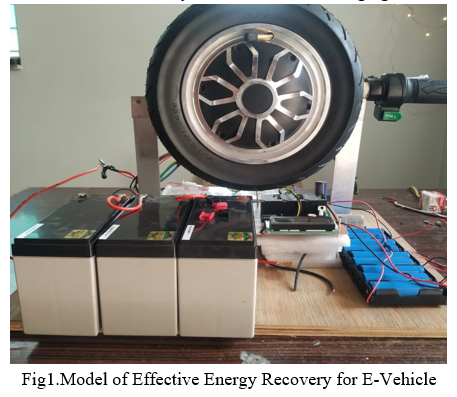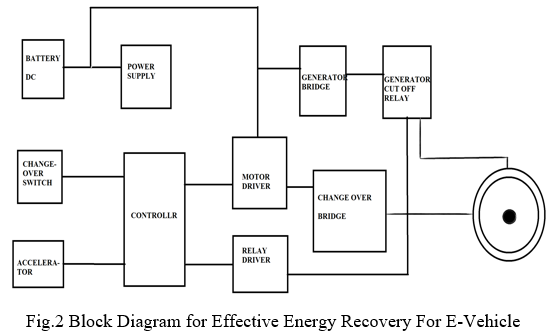Ijraset Journal For Research in Applied Science and Engineering Technology
- Home / Ijraset
- On This Page
- Abstract
- Introduction
- Conclusion
- References
- Copyright
Effective Energy Recovery System for E-Vehicle
Authors: Nikhil .L. Bujade, Aditya G. Raut, Shivani A. Naware, Prof. Abhay Halmare
DOI Link: https://doi.org/10.22214/ijraset.2022.41496
Certificate: View Certificate
Abstract
To improve driving ability of electric vehicle. Regenerative braking system (RBS) are an effective method of recovering the energy released and at the same time reducing the exhaust and brake emissions of vehicle. This method is based on the principle of converting the kinetic energy created by mechanical energy of the motor into electrical energy and the converted electrical energy is stored in battery for later use. These system provide economic benefits via fuel saving. This use also contribute to a clean environment and renewable energy source.
Introduction
I. INTRODUCTION
Due to the rapid increase in the World population, the number of vehicle is also rising, serious threats to the environment and human health brought about by vehicle related emission include air pollution, global warning, and the rapid depletion of petrol resources. These problem force countries to take measures to ensure clean air, energy savings, and novel energy application. In addition, the resulting worldwide energy crisis compels nations to turn to alternative energy sources and to retain maximum energy from existing resources. Regenerative braking systems are among these important energy saving applications.
In EVs, this is one of the most important units for saving fuel and energy. Although this unit has the same characteristics as in conventional vehicles, it enables the storage of the vehicle’s energy during driving and braking .This braking energy stored in the system can be reused. Therefore, these vehicles are in high demand due to the alarming increase in air pollution and petrol prices. These vehicles have the advantages of low emission, low noise, and high energy efficiency.
Another major disadvantage of purely EVs is the use of batteries as the only energy source, which causes problems because of long charging time, low specific power, and the inability to meet the short-term power requirements of the vehicles. Therefore, the acceleration, climbing, braking performance, and energy recovery efficiency of the motor are seriously affected and the power requirements of the advantage of the EV is that as the energy storage system, the battery has high energy density and a very large storage capacity. Moreover, advanced battery technology offers a longer service life for batteries. In this way, EVs use the RBS to increase energy efficiency by recovering some of the braking energy. The high cost of batteries and the limitations of their use in heavy vehicles are also disadvantages of these new-generation vehicles.
II. EFFORTS TOWARDS POLLUTION CONTROL
Not only does regenerative braking improve fuel efficiency in EVs, but also it can be adapted for the ICEV to help lower vehicle emissions. When we switch to petrol vehicles into electrical vehicles it help keep your town and your world clean. In general EVs produce fewer emissions that contribute to climate change and smog than conventional vehicles. Most of Emissions are emitted through the tailpipe, through evaporation from the fuel system, and during the fuel process. direct emissions include smog- forming pollutants (ex-nitrogen oxide), other pollutants harmful to human health, and greenhouse gases, primarily carbon dioxide. All-electric vehicles produce zero direct emissions, which specifically helps improve air quality in urban areas.
III. THE STRUCTURE WORKING PRINCIPLE OF REGENERATIVE BRAKING SYSTEM
In recent times, electric vehicles have received much attention as an alternative to traditional vehicles powered by internal combustion engines running on non renewable fossil fuels, The most common form of Regenerative brake involves using an electric motor as an electric generator. The most common form of Regenerative brake involves using an electric motor as an electric generator. The working of the regenerative braking system depends upon the working principle of an electric motor, which is the important component of the system. Electric motor gets activated when some electric current is passed through it. But ,when some external force is applied to activate the motor , then it behaves as a generator and generates electricity.
Regenerative braking is braking method that provides charge to the battery by converting the mechanical energy of the motor and kinetic energy into electrical energy. In regenerative braking mode the vehicles slows down on an incline. When force applied to the brake pedal. the vehicle slows down and the motor runs in the opposite direction.
When the operating in opposite direction ,the engine acts as a generator and converts torque energy into electrical energy. Which results in regenerating electric energy for storage in the battery and simultaneously reducing the speed of the vehicle with the regenerative resistance of the electric motors. This electricity is then used for recharging the battery.

IV. EQUIPMENT
A. Brushless Dc Hub motor 350 w
B. PIC micro controller- 16F
C. RELAY - SPDT 30A
D. Relay Driver 16PIN UIN2003.
E. Regulator IC 7805
F. LCD display
G. Capacitor input filter 1000 microfarad
H. Capacitor for storage 5V - 220 F
I. Battety Pack 26V
J. 3phase bridge Rectifier
K. Resistance
L. Battery
V. BLOCK DIAGRAM

VI. WORKING
Here, we are using brushless DC motor of 36 volts which is running with the help of battery power. Then the motor controlled through the controlled unit block diagram of electric vehicle system work in step such as charger battery, power controller and wheel.
The PCB requires 12 v supply for its operation. We are using three batteries in series of 12 V 7.5A for supplying this capacitors. The PCB is connected to single battery. Initially, the LED screen displays battery voltage and acceleration percent. the microcontroller is program such that when the acceleration throttle is given more than 30 %, it relay pickup and the motor runs in motoring mode but as the acceleration drops below 30 % , it sends command to switch of relay and motor runs in generating mode.
The LED display the voltage being used while motor runs in motoring mode and as the throttle drops below 30 % the voltage being generated by the motor in generating mode. The generated voltage is stored in separate battery pack which can be later used to supply the motor by simply switching between main battery and battery pack.
VII. OBSERVATION TABLE
|
SR.NO |
MAIN BATTERY VOLTAGE |
MAIN BATTERY DISCHRGE TIME |
GENERATED BATTERY PACK VOLTAGE |
BATTERY PACK CHARGING TIME |
|
1.
|
37.5 |
0 |
28 |
0 |
|
2.
|
36.5 |
2 MIN |
27.9 |
2 MIN |
|
3.
|
36.4 |
5 MIN |
28.5 |
5 MIN |
|
4.
|
36.3 |
10 MIN |
27.9 |
10 MIN |
|
5.
|
36.2 |
12 MIN |
28.4 |
12 MIN |
|
6.
|
37.2 |
15 MIN |
29.6 |
15 MIN
|
VIII. CALCULATION
A. Drag Force
Average speed of vehicle = 40km/h
Fd= cd * ½ *P* (v*v) A
Fd = Drag force (N)
cd = Drag coefficient
P = density of fluid (1.2kg/m3 for air)
v = flow velocity (m/s)
A = frontal area of body (m2)
A= 1.5m (Height)*0.4m (Width)
A= 0.6m2 now,
Fd = 0.9*1/2*(1.2kg/m3) *(11.11*11.11) *(0.6m2)
= 39.99N
Fd = 40 N
B. Power Required for Motor
P=Fr * v/n
P= power
Ft= Total force
n= Efficiency
P= (7.5+40) * 11.11/0.85
P= 530.32 w
C. Rolling Resistance
Fr = c*w
C = Rolling Resistance coefficient
W = m * a c = 0.002 on concrete c = 0.004 on asphalt
Fr = 0.004*190*9.81
Fr = 7.45 N
D. Torque
Circumference = 2*3.14*(Radios)
= 2*3.14*0.25
= 1.57m
For one Revolution of wheel we will cover the distance of
1.57 m
For 40 km
40(km/h) =40000 (km/s)
= 40000/60
= 666.6 (meter/minute)
Wheel RPM = 666.6/1.57
= 424.5 RPM
D=0.5m
R= 0.25m
C= 2*3.14*r
Motor RPM = gear ratio * wheel RPM
= (Driven/Drive) * 424
= (21/9) * 424
Motor RPM = 1000 rpm
Torque = 9.5488*Power/speed
= 9.5488*530/989 Torque
= 5.48 N-M maximum Torque (0-40km) in 20 sec
By 1st equation of motion
V= u + at
V = final velocity (m/s)
U= initial velocity (m/s)
a= acceleration (m/s2)
T= time taken in (s)
V= u + at 11.11= 0+ (a*20) a = 0.55 m/s Force
F=M*a
= 190*0.55
= 104.5 N
Maximum Torque = F*r(radios)
= 190*0.25
= 26.125 N-M
Maximum torque= 26.125N-M
E. Ampere Hour (Ah) Required for Battery
Battery voltage= 36 volt
Motor Wattage= 350 w
Discharging current = 350 / 36
= 9.72Amp
F. Power Consumption in one Hour 350w * 1 hr
= 350whr
But Efficiency of Battery is 80%
Therefore,
Power consumption in one hour = 350*1.16
= 406 whr
Now,
(Ah) required = 406/36
= 11.27 A hr
G. Electricity Consumption for Charging Battery
Charging voltage = 54.6 volt
Charging current = 26 Ah
Power = 54.6*26
= 1419.6 w
Total Energy consume in 4 hours = 1419.6*4
= 5678.4 wh
One unit of electricity = 1000 wh
Total unit consumption = 5678.4/1000
= 5.67 unit
Cost of charging = 5.67* 7
= 39.75 Rs
IX. REGENERATIVE BRAKING EFFICIENCY
conventional vehicles energy efficiency is only about 20%, with remaining 80 % of its energy is converted to heat through friction. The most incredible thing about regenerative braking is that it able to capture as much as half of that wasted energy put it back to work. This could reduce fuel consumption by 10% to 25%.
In future that may see the end of fossil fuel reserves that have provided us with energy for automotive and other technologies for many years, and in which fears about carbon emissions are coming to a peak , this added efficiency is becoming increasinglZ important.
X. EXPECTED OUTCOMES
A. It should store energy while braking while braking which is its primary objective.
B. It should return the stored energy whenever required easily.
C. It should be compact and easy to install.
D. It should provide adequate stopping /braking force to the vehicle.
E. Using concept of Electric vehicle result in better efficiency and also save lot of fuel in today's fuel deficit world.
F. One can surly concluded that this concept will follow with even better efficiency and conversion rate.
XI. OBJECTIVE AND SCOPE
Regenerative braking systems require further research to develop a better system that captures more energy and stops faster. As the time passes, designers and engineers will perfect regenerative braking systems, so these systems will become more and more common. All vehicles in motion can benefit from these systems by recapturing energy that would have been lost during braking process and thereby reducing fuel consumption and increased efficiency. Future technologies in regenerative brakes will include new types of motors which will be more efficient as generators, more powerful battery which can bear more frequent charging and discharging, new drive train designs which will be built with regenerative braking in mind, and electric systems which will be less prone to energy losses. Of course, problems are expected as any new technology is perfected, but few future technologies have more potential for improving vehicle efficiency than does regenerative braking.
XII. ACKNOWLEDGEMENT
This research was guided by our mentor and coauthor Prof. Mr.Abhay Halmare, by contributing excellent suggestions and support from an initial level and giving us knowledge throughout the project. We would also like to express our acknowledgement to the Head of the Department of Electrical Engineering, Dr. Shubhangi Ambekar, at KDK College of Engineering and Technology, RTMNU Nagpur for their cooperation.
Conclusion
This study presents information about the principles and properties of regenerative braking systems. automation, electromechanical, and constructive studies have been carried out in this field in order to boost recovered Many energy efficiency and reduce operating costs. the most of the economic losses worldwide are caused by mechanical wear, the importance of regenerative braking systems has become better recognized. Safety, comfort, and economic aspects can be increased by developing these brake systems. Regenerative braking systems, currently in limited use in electric vehicles, can also be used in conventional braking or other motion control systems. When they are widely used, economic input can be obtained by the reduction of mechanical losses and energy savings can be achieved as a result of the recovered electrical energy.
References
[1] F.E. Jamerson, “Electric bikes worldwide 2002: With electric scooters & neighborhood EVs,” Electric Battery Bicycle Co, Naples, FL, 2002 [2] W.C. Morchin, “Battery-powered electric bicycles,” in Proc. Northcon’94, Oct. 11–13, 1994, pp. 269–274. [3] H. Oman, W.C. Morchin, and F.E. Jamerson, “Electric-bicycle propul-sion power,” in Proc. WESCON’95, Nov. 7–9, 1995 [4] Li, Y.; Yang, J.; Song, J. Nano energy system model and nanoscale effect of graphene battery in renewable energy electric vehicle. Renew. Sustain. Energy Rev. 2017 [5] Review Paper on Electric Vehicle Charging and Battery Management System , Author Kadlag Sunildatta Somnatha, Mukesh Kumar Gupata, May 17, 201 [6] Review of Electric Vehicle Technologies, Charging Methods,Standards and Optimization Techniques Syed Muhammad Arif , Tek Tjing Lie , Boon Chong, Soumia Ayyadi and Kristian Jensen. [7] Malode, S. K., & Adware, R. H. (2016). Regenerative braking system in electric vehicles. International Research Journal of Engineering and Technology (IRJET) [8] NIAN, X., PENG, F., & ZHANG, H. (2014). REGENERATIVE BRAKING SYSTEM OF ELECTRIC VEHICLE DRIVEN BY BRUSHLESS DC MOTOR. IEEE TRANSACTIONS ON INDUSTRIAL ELECTRONICS [9] RAHMAN, K. M., FAHIMI, B., SURESH, G., RAJARATHNAM, A. V., & EHSANI, M. (2000). ADVANTAGES OF SWITCHED RELUCTANCE MOTOR APPLICATIONS TO EV AND HEV: DESIGN AND CONTROL ISSUES. IEEE TRANSACTIONS ON INDUSTRY APPLICATIONS [10] Ranjan Kumar ,Department of Mechanical Engineering, Indian School Of Mines, Dhanbad, “Regenerative Brake: To Harness the Kinetic Energy of Braking” JETIR (ISSN-2349-5162) January 2015, Volume 2, Issue 1 [5] Benjamin, C Kuo -Automatic control systems
Copyright
Copyright © 2022 Nikhil .L. Bujade, Aditya G. Raut, Shivani A. Naware, Prof. Abhay Halmare. This is an open access article distributed under the Creative Commons Attribution License, which permits unrestricted use, distribution, and reproduction in any medium, provided the original work is properly cited.

Download Paper
Paper Id : IJRASET41496
Publish Date : 2022-04-15
ISSN : 2321-9653
Publisher Name : IJRASET
DOI Link : Click Here
 Submit Paper Online
Submit Paper Online

